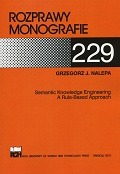Table of Contents
Semantic Knowledge Engineering Approach
SKE Monograph
Summary of the Results
In this monograph important results that address current practical problems in Knowledge Engineering are presented. They provide solutions that are not only important, but in a number of cases they constitute a unique contribution of the author to this research domain. These important results have been presented as follows:
Chapter 3 introduces the Semantic Knowledge Engineering approach. It gives a comprehensive overview of an original knowledge representation and design methods as well as new tools proposed for the approach. In the chapter a new complete hierarchical design procedure is introduced. Based on it, a heterogeneous architecture of knowledge-based applications is proposed by the author.
Chapter 4 presents a complete formalization of the XTT rule representation language, including its syntax and semantics. The language ensures high density of knowledge representation by combining decision trees and decision tables. Contrary to traditional, flat rule bases, the representation is focused on grouping similar rules into decision components, rather than on designing single rules. It forms a transparent and hierarchical visual representation composed of the decision components linked into an inference network. In the chapter the structure of the XTT knowledge bases is described in detail. Moreover, original inference procedures for them are proposed. The chapter also contains original methods for rule verification and the detection of logical rule anomalies.
Chapter 5 contains a description of a new design, implementation and analysis environment for XTT-centric design of Rule-Based Systems. The environment supports all phases of the design process. The proposed set of tools allows for conceptual prototyping of the XTT knowledge bases, and their logical design with formalized verification and detection of logical anomalies. The implementation of systems containing an XTT-based logical core is also supported.
Chapter 6 introduces an original rule-based knowledge engineering framework for the Semantic Web. The framework contains a formal calculus for integrating the XTT rules with Description Logics, called DAAL. Moreover, it offers a hybrid reasoning engine, PELLETHEART, that is able to use rules with ontologies. The framework can be practically used with a new knowledge engineering tool LOKI which extends the semantic wiki functionality.
Chapter 7 discusses an original bi-directional translation of the XTT rule-based representation to the UML notation used in Software Engineering. The translation preserves the semantics of the XTT model. It is a valuable tool for designing applications in the heterogeneous architecture, where a logical application core is clearly identified. The primary motivation for this translation is to provide an illustrative representation of the XTT logical model. This representation uses the notation that software engineers are familiar with.
In the Semantic Knowledge Engineering approach, rule language used to build the knowledge-based model is formalized not only on the syntactic, but also on the semantic level. Moreover, the semantics of language expressions (atomic formulae) is considered, including the relations between these expressions. The semantics of the logical inference process is considered. A number of inference methods for the same knowledge base built with the language is provided. Their application depends on the needs of the user and is not determined by a single algorithm. Moreover, logical aspects of the model quality are discussed. It is possible to detect certain semantic anomalies of the model. The semantic aspects of the design process of the model are considered, and the process is precisely defined in several consecutive phases. These correspond to different levels of abstraction of the knowledge the designer has.
To summarize, the original contribution of this monograph in the fields of Computer Science and Artificial Intelligence is the following:
- Development of formalization of the syntax and semantics of the XTT rule language and knowledge bases, presented in Chapter 4.
- New rule inference methods in modularized knowledge bases, as well as procedures for detection of logical rule anomalies, introduced in Chapter 4.
- A proposal and integration of the complete design, analysis, and implementation tool set, presented in Chapter 5 using examples.
- An original rule-based knowledge engineering framework for the Semantic Web, offering rule representation and processing methods for Description Logics, introduced in Chapter 6.
- A comparative analysis and semantic translation of the rule-based representation to the UML notation used in Software Engineering, discussed in Chapter 7.
The presented approach has been applied in several areas as discussed in this monograph. These include knowledge management, Business Rules, Software Engineering and the Semantic Web. Moreover, other applications not discussed in the monograph include soft-real time control of mobile robots, and the design of reliable computer security systems. All of the above mentioned topics have been discussed in other papers by the author.
Habilitation Degree
Based on the monograph, as well as the set of important papers, I successfully passed the habilitation procedure, and received the habilitation degree (DSc) in Computer Science, at AGH UST on 2012.05.10.
